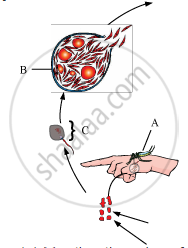Advertisements
Advertisements
Question
Many diseases can be diagnosed by observing the symptoms in the patient. Which group of symptoms are indicative of pneumonia?
Options
Difficulty in respiration, fever, chills, cough, headache
Constipation, abdominal pain, cramps, blood clots
Nasal congestion and discharge, cough, constipation, headache
High fever, weakness, stomach pain, loss of appetite and constipation
Solution
Difficulty in respiration, fever, chills, cough, headache
APPEARS IN
RELATED QUESTIONS
Name of parasite the causes filariasis in humans. Mention its two diagnostic symptoms. How is this transmitted to others?
Study a part of the life cycle of malarial parasite given below. Answer the questions that follow:

(a) Mention the roles of ‘A’ in the life cycle of the malarial parasite.
(b) Name the event ‘C’ and the organ where this event occurs.
(c) Identify the organ ‘B’ and name the cells being released from it.
Mention any four methods involved in the treatment of cancer.
A patient was hospitalized with fever and chills. Merozoites were observed in her blood. What is your diagnosis?
Pons varolii in human brain lies:
Which of the following sets of diseases is caused by bacteria?
Widal test is carted out to test:
Pneumonia is caused by ______.
The following table shows certain diseases, their causative organisms and symptoms. Fill the gaps.
| Name of the Disease | Causative organism | Symptoms | |
| (i) | Ascariasis | Ascaris | ______ |
| (ii) | ______ | Trichophyton | Appearance of dry, scaly lesions on various parts of the body |
| (iii) | Typhoid | ______ | High fever, weakness, headache, stomach pain, constipation. |
| (iv) | Pneumonia | Streptococcus pneumoniae | ______ |
| (v) | ______ | Rhino viruses | Nasal congestion and discharge, sorethroat, cough, headache |
| (vi) | Filariasis | ______ | Inflammation in lower limbs |
Write the mode of transmission for the following diseases:
Typhoid
